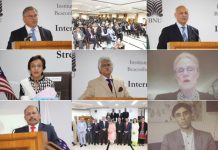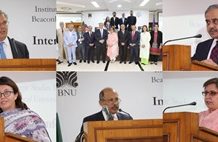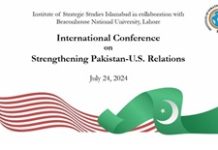A futile agenda?
In what is clearly a preemptive move to set the tone of discussions with PM Nawaz Sharif during his visit to the US and his meeting with President Obama on October 23, the United States according to reports “quietly” took a decision to release more than $1.6 billion in military and economic aid to Pakistan. Earlier on October 19, even as Pakistani government officials laid out the contours of the PM’s meeting agenda with President Obama – drone attacks; Afghanistan and the US withdrawal in 2014; trade and firm bilateral economic ties et al – the State Bank of Pakistan confirmed that it has received $322 million due to Pakistan in lieu of the Coalition Support Fund (CSF) for its support in the war on terror.
Lest we start congratulating ourselves for having brought the US around despite the government shutdown there, to having seen the light in developing a meaningful long-term relationship with Pakistan on a “more firm and less personalized footing” as Khurram Dastgir Khan, Pakistan’s minister for privatization and commerce told VOA on the eve of the PM’s departure, it would be prudent on the part of Pakistan to read between the lines. The United States does not hand out free lunches.
The release of such large amounts for Pakistan must be seen in the background of the US withdrawal from Afghanistan in 2014 and its dire need of the 1,000 miles of Pakistan road space for moving out troops and heavy military equipment from there. The decision to release $1.6 billion will put Nawaz on the back foot in terms of his discussion agenda with President Obama. It has already been made clear that this money will begin reaching Pakistan in 2014 and would take several years to be fully disbursed.
The message is implicit. The PM would have to make firm commitments to Obama for a smooth transit of the US and NATO forces in July 2014 if his government wants to see a single cent of the ‘quiet’ release of the $1.6 billion aid. This would entail provision of assurances that the Afghan Taliban are brought around to the negotiating table for a smooth election process in Afghanistan in April 2014; a harassment free withdrawal of foreign troops, and most important of all sticking to mere lip service on drone attacks by the US.
Any disagreement on these demands and the ‘quiet’ release would be as quietly delayed.
The old US ‘carrot and stick policy’ is more than evident here. The ‘carrot’ has already been dangled, the ‘stick’ will be wielded at the discussions in Washington. The release of the CSF and new aid package are clearly designed to ask the Pakistani PM to now ‘do more’ in order to help the US achieve an orderly withdrawal of its forces from Afghanistan come 2014. The October meeting therefore will be all about what the US wants from Pakistan, and not about what the PM has to tell Obama about the violation of Pakistan’s sovereignty by US drones or the attention that Kashmir deserves from the international community.
To be sure, all of his demands would be falling on deaf ears – unwilling to hear such stuff for a very long time now. The US will not be forgoing the use of drones any time before 2014 when requirement of ‘force protection’ will reduce the need for unmanned strikes. Even beyond 2014, it would be futile to expect the drone to be taken out as a tool of war strategy. It would therefore be meaningless to raise this issue, unless Pakistan is really willing to take steps that would deter the use of drones on Pakistani soil. Memory is still fresh on what happened when the PM raised the issue at the UN forum last month. As for Kashmir, the issue will not be moving beyond media headlines in Pakistani newspapers, now that the Americans have finally decided on the choice of their future ally in the region.
On the economic side too, it has now been several years that Pakistan and the US have been talking about a bilateral investment treaty (BIT). It would of course be a measure of considerable success if the PM were to come back with a signed document in this respect. That would certainly help pessimists like me to shun our negativity about Pakistan-US relations moving beyond the short-term gains for both.
However, keeping in mind the rollercoaster nature of Pak-US relations over the last six decades, one cannot help but be pessimistic about the outcome of the PM’s visit.
Of course there is much to hope for taking into consideration that at this point in time the US need for Pakistan is going to be high owing to the 2104 withdrawal. On the other hand, lest one forget, the history of Pak-US relations, the very foundation on which the two countries are now planning to raise the future structure, is going by its ‘architecture’ unstable.
The proof of this instability can be found in its history that has invariably been based on short-term tactical gains for both sides: for example, Pakistan’s support in the fight against communism from the 1950s to the Soviet withdrawal from Afghanistan in 1989. And, in the post-Soviet era, much of the relationship has revolved around the US ‘war on terror’ and Pakistan’s support to ‘disrupt, dismantle and defeat’ the militant Muslim groups – namely Al-Qaeda and the Taliban in Afghanistan and Pakistan.
In the fight against communism, and now against terrorism, Pak-US relations therefore have thrived primarily only when the US ‘national’ interests have faced external threats. Much of the US assistance to Pakistan consequently has invariably gone into reinforcement of Pakistan’s security apparatus at the cost of ignoring the long-term developmental growth of the country in sectors such as economic, agriculture, trade and investment and industry.
If the US in next five years is able to build on high impact, high visibility infrastructure programmes in Pakistan that will be visible to the people of Pakistan, and whose affect is clearly felt to have made a difference, only then can one claim that the ‘new phase’ has begun to make a dent in the overwhelming hostility that the majority in Pakistan feel towards the US. Only then can the government and the people of the two countries move towards constructing a relationship that will improve people’s lives, reduce the ‘trust deficit’ and help take Pakistan-US relationship beyond the rhetoric.
Views expressed are of the author and do not necessarily reflect the views of ISS or of the Government of Pakistan.













